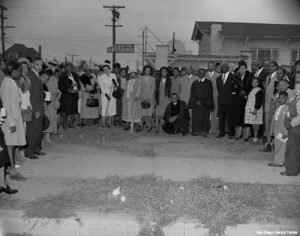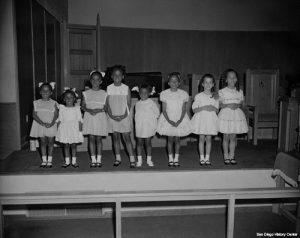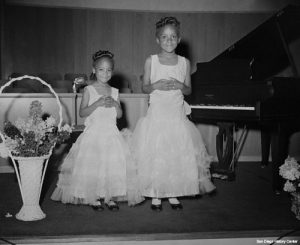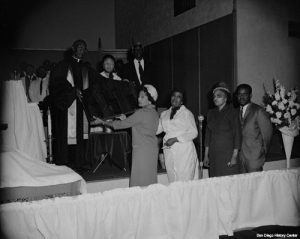An essential part of human communication is the freedom to gather peacefully without fear of discrimination and persecution. It has been documented throughout history the conflict that has occurred when a majority group dominates an area and oppresses the minority population. The struggle of free and enslaved black people at the hands of white-founded churches and mainstream denominations is an example of segregation in the United States. The enslaved blacks were forced to practice the same worship habits as their white masters and were not able to worship freely. This caused enslaved people to develop secret meeting places in order to avoid the supervision of slave owners.[1] The work of freed blacks and former slaves led to the creation, development, and growth of new denominations that did not discriminate based on the color of skin. These churches provided a space for black communities to peacefully worship without the worry of white suppression. Richard Allen established the Bethel African Methodist Church in Philadelphia, Pennsylvania in 1794 to function as a space for black people to freely worship God. The denomination adopted similar organization and doctrines of the Methodist Episcopal Church. The spread of the Bethel AME Church made its way to the west coast in 1887 as Mr. and Mrs. Solomon Johnson opened the first black church in San Diego, California. The establishment of Bethel AME was a key moment in the history of African Americans in San Diego. The church became a symbol of growth and change for the black community that was previously absent repressed. The formation of Bethel AME in San Diego made it possible for black culture and religious practices to thrive. The black community in San Diego was able to become independent and self-defined in a dominant white environment.
The African Methodist Episcopal Church is one of the largest African American denominations worldwide. It grew out of the Free African Society, a mutual aid association, founded by Absalom Jones, Richard Allen, and other black members of their community. They had all been members of St. George’s Methodist Episcopal Church, but decided to leave after they had received discriminatory and inhumane treatment from the white parishioners. The founding members were tired of having to avoid the “whites only” section of the church.[2] the Mother Bethel African Methodist Episcopal Church became the first church established by this group. It is the oldest parcel of land in the United States that has been owned continuously by African Americans. The new denomination was founded with two specific principles: to counter the racism encountered by blacks everywhere and to recapture the straying American Methodism.[3] Allen and the AME Church were known for their work in support of antislavery causes. The expression “black churches” is often in reference to organizations like the AME Church. The “black church” refers to four groups: denominations founded by, formed of, and led by blacks; black congregations that belong to white denominations; independent congregations; and loose fellowships of black churches.[4] The conception of black churches reflected the black political thought of that time period. Allen not only pushed for emancipation, but for black emigration to Haiti. The abolitionist and education reform movements were tied to different black churches in the United States, not just Bethel AME. The mission of the African Methodist Episcopal Church today includes the spiritual, intellectual, physical, emotional, and environmental needs of all individuals in the community.[5] The same universal rights that served as pillars to the founders’ values can be seen in the work of the Bethel AME Church today.
The organized religious life in San Diego can be traced back to as early as 1769 and followed to the present day.[6] It was first established in Old San Diego by the Roman Catholics with priests from the mission. The religious history of San Diego is majority white. However, the religious makeup of the city was very inclusive and contained a wide range of denominations. There were no congregations with a majority black population until Bethel AME was established. This is ironic because the black presence in San Diego was established long before whites had arrived.[7] Enslaved blacks were first introduced during the Spanish and Mexican periods in early California. Prior to the population boom in the 1880s most of the new black arrivals were slaves, ex-slaves, or employees of whites.[8] The rural areas outside of San Diego became crowded with the black population. They found that, compared to life in the city, rural areas provided more economic advantages. The communities started to focus on farming as the primary source of income. This helped create an institutional racism that restricted the opportunities of the black community.[9] The creation of rail connections in the last part of the nineteenth century accelerated the economy in San Diego. It coincided with the city’s growing downton and black population. There were black businesses opening in the city that catered to all races. Though there were no lynchings or organized white opposition, the black population was often treated as outcasts and referred to as “uncle,” “aunt,” or “nigger” in mass media and news publications.[10] To satisfy the need for a racially inclusive religious setting that was without discrimination and hatred, the Bethel AME Church was founded in 1887.
The original congregation of the Bethel AME Church met in the home of Mr. and Mrs. Solomon Johnson, at “F” and Union Streets, before the first church was built.[11] They built a hall in 1896 before building a church in 1912. In the early 1920s the Bethel AME Church served as the first meeting place for the Girl Reserves.[12] It was a group that was open for ten to eighteen-year old black girls. It was opposed to the original YMCA club that was exclusive to white girls and gathered in a separate meeting facility. In its conception, Bethel AME worked to develop children and young adults to be recognized leaders. The first church remained at the original site until 1939. The building and renovation of a new church did not finish until after 1950. The leadership of the Bethel AME Church has changed multiple times throughout its 125-year history. The vision of these leaders has remained the same: to create an area in which the religious practice of African American can take place peacefully and to engage the community and challenge its members to be involved with outreach.[13] The different pastors of the church worked to pursue the vision of “Building a Bethel,” while remembering its history of struggle. The establishment of the physical church helped to provide freedom to the black community in San Diego. It acted as a haven for the black community in the white dominated areas of the city. Bethel AME continues its mission of feeding the hungry, clothing the naked, housing the homeless, cheering the fallen, and providing jobs for the jobless in San Diego.

This is a groundbreaking ceremony for the Bethel AME Church. The date is not included in the photo but some members in the crowd are holding shovels.

This is a Sunday school group at the Bethel AME Church. The picture reinforces the theme of educating the youth in order to become leaders of the future.

The two girls are performing at a piano recital that was held at the Bethel AME Church.

This is the Building Fund Committee at the Bethel AME Church. The history of the church includes the work of the pastors and parishioners to “Build a Bethel,” a place where blacks could come and worship peacefully and a large sanctuary.

A ceremony is being held at Bethel AME. This is the site of the first church on “K” and 31st Street in San Diego.
***Photographs are provided by the San Diego History Center***
[1] David Michael, “Black Churches,” The American Mosaic: The African American Experience, accessed April 10, 2019, https://africanamerican2-abc-clio-com.sandiego.idm.oclc.org/Se arch/Display /1477639.
[2] Pearl Bates, “African Methodist Episcopal Church,” The American Mosaic: The African American Experience, Accessed April 10, 2019, https://africanamerican2-abc-clio-com.sandiego.idm.oclc.org/S earch/Display/1477737.
[3] Bates, “African Methodist Episcopal Church.”
[4] Michael, “Black Churches.”
[5] “Bethel A.M.E. Church History.” Bethel African Methodist Church Episcopal Church, 2019.
[6] William Ellsworth, “History of San Diego, 1542-1908,” (San Diego: The History Company, 1908).
[7] Gail and Malone, “Black Pioneers in San Diego 1880-1920,” The Journal of San Diego History 27, no. 2 (Spring 1981).
[8] Gail and Malone, “Black Pioneers in San Diego 1880-1920.”
[9] Charla Wilson, “Why the Y?: The Origin of San Diego YMCA’s Clay Avenue Branch for African Americans.” The Journal of San Diego History 62, no. 3 & 4 (2016).
[10] Gail and Malone, “Black Pioneers in San Diego 1880-1920.”
[11] “Bethel A.M.E. Church History.”
[12] Charla Wilson, ““Why the Y?: The Origin of San Diego YMCA’s Clay Avenue Branch for African Americans.”
[13] “Bethel A.M.E. Church History.”
Bibliography
Bates, Pearl. “African Methodist Episcopal Church.” In The American Mosaic: The African American Experience, ABC-CLIO, 2019. Accessed April 10, 2019. https://africanam erican2-abc-clio-com.sandiego.idm.oclc.org/Search/Display/1477737.
“Bethel A.M.E. Church History.” Bethel African Methodist Church Episcopal Church, 2019. Accessed April 22, 2019. http://bethelamesd.com/about-us/.
Ellsworth, William. History of San Diego, 1542-1908. San Diego: The History Company, 1908.
Madyun, Gail & Larry Malone. “Black Pioneers in San Diego 1880-1920.” The Journal of San Diego History 27, no. 2 (1981): Accessed April 9, 2017. https://sandiegohistory.org/journal/19 81/april/blacks/.
Michel, David. “Black Churches.” In The American Mosaic: The African American Experience, ABC-CLIO, 2019. Accessed April 10, 2019. https://africanamerican2-abcclio-com.san diego.id m.oclc.org/Search/Display/1477639.
Wilson, Charla. “Why the Y?: The Origin of San Diego YMCA’s Clay Avenue Branch for African Americans.” The Journal of San Diego History 62, no. 3 & 4 (2016): Accessed April 9, 2017. https://sandiegohistory.org/journal/2016/july/why-the-y-origin-of-sd-yw caclay-aven ue-branch-for-african-americans/.

